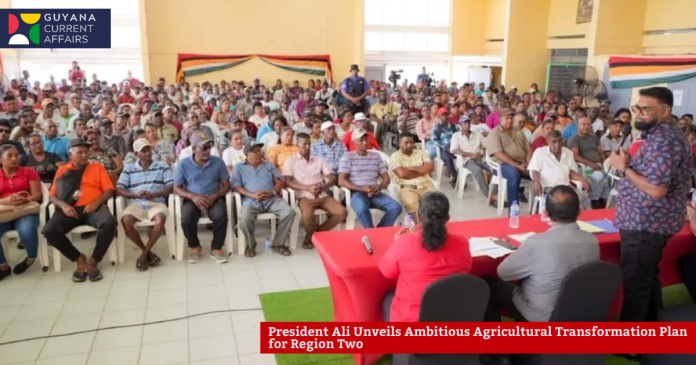President Dr. Irfaan Ali has launched a sweeping agricultural plan for Region Two (Pomeroon-Supenaam), promising to unlock new opportunities for thousands of farmers, modernize infrastructure, and position the region as a national leader in food security and agritourism.
Addressing a packed gathering of rice farmers, cash crop growers, and fisherfolk at the Anna Regina Multilateral School, President Ali outlined a vision centered on land access, capital investment, and value-added production. The government will open up 20,000 acres of new farmland in three agricultural clusters across the Essequibo Coast, directly tackling the persistent challenge of high rental costs faced by small-scale farmers.
“We are going to invest, in the coming months, to open up at least 20,000 acres of land in three different clusters here in Essequibo,” President Ali announced. This initiative is designed to benefit small farmers—especially those cultivating 30 acres or less—by providing them with direct access to land, eliminating the need to rent from absentee landowners.
Each agricultural cluster will be equipped with essential machinery, including backhoes, tractors, and combine harvesters. Farmers will manage these resources collectively, sharing maintenance costs and reducing input expenses. In a further boost, those with 30 acres or less will be able to choose between receiving cash or fertilizer, allowing them to tailor support to their needs.
To address post-harvest challenges, the government will construct two modern drying and storage facilities in the region. These state-of-the-art centers will help farmers and fisherfolk combat losses caused by unpredictable weather and stabilize prices for perishable goods. Additionally, three cold storage facilities will be established to support both crop and fish production, creating new agribusiness opportunities.
President Ali also revealed plans to diversify income sources for the region’s fishing communities. Swamp shrimp and prawn farming will be introduced as part of a major aquaculture initiative, broadening the economic base for fisherfolk and their families.
Infrastructure upgrades are a central feature of the plan. Back dam access roads will be converted into durable, hard-surfaced routes using crush-run materials, improving farm access, reducing spoilage, and cutting transportation costs. The government will also invest in drainage and irrigation systems, ensuring that new lands are farm-ready and resilient to climate impacts.
To further boost farmers’ income, the plan encourages the development of one acre out of every ten for high-value, high-yield crops. The government is committed to co-investing in these ventures, including providing blended fertilizers tailored to specific crop needs.
A new price stabilization buffer fund, developed in collaboration with millers, will help protect rice farmers from market volatility and ensure predictable payments. Extension services will be expanded through a central control center and local container offices, offering 24/7 technical support and guidance.
President Ali emphasized that these investments are part of a broader strategy to transform Region Two into a hub for food production and tourism, with agritourism as a key theme. “You have a government that stands with you through good times and bad. See the opportunity in agriculture,” he told farmers.
Minister of Agriculture Zulfikar Mustapha highlighted the sector’s transformation since the government’s return to office, citing improved rice prices, expanded support for cash crop farmers, and upgraded infrastructure for fisherfolk.
Farmers at the event expressed gratitude for the government’s direct interventions, including the purchase of paddy during the current crop and reduced ferry transportation fees. Many voiced hope that the new land and storage facilities would further ease their burdens and enable them to thrive.
With billions already invested in Region Two’s agriculture and infrastructure, President Ali’s progressive plan signals a new era of growth, resilience, and prosperity for the Essequibo Coast.


